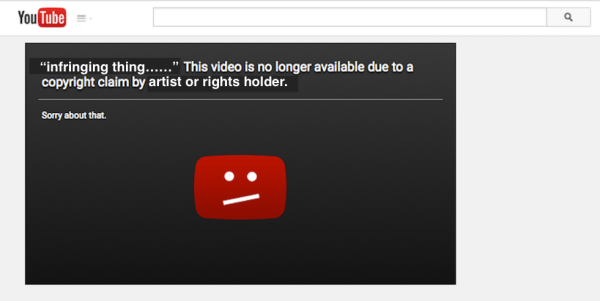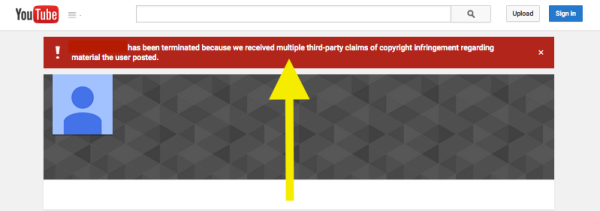More YouTube User Accounts Terminated Owing To Copyright Infringement
As more artists become aware of how detrimental pirated user content on YouTube can be to their livlihoods they are, with increasing frequency, using the Digital Millennium Copyright Act as a means to shut down infringing accounts.
__________________________________
Guest Post by David Lowery on The Trichordist
We’ve been hearing from a number of our artist friends who are getting more proactive about using the DMCA to manage their work on YouTube. They are reporting that there appear to be more account terminations on YouTube in recent months. This would appear to be happening due to a number of factors, not the least of which is that artists, songwriters and creators are finally becoming aware of just how damaging “User Pirated Content” on YouTube really is to their careers.
Readers will note that the account in the screen shot above was terminated due to “multiple third-party claims“. That means the YouTube user is indiscriminately uploading multiple works by multiple parties. Unfortunately this appears to be a very common case with many users.
This is a serial infringer – it is not someone “just sharing their cute cat video.” There are literally thousands upon thousands of YouTube channels that are nothing more than infringement farms where artists get paid a pittance, if anything at all.
YouTube user accounts are subject to a three strikes rule. Yup, that’s it, three strikes – and now it appears more parties than ever before are starting to exert their rights via the DMCA and are sending notices to remove infringing works on the video streaming site.
This is how users, and the general public at large, learn about copyright infringement. When an account is terminated the YouTube user is learning about copyright and artists rights. Those users should be directed to the artists YouTube channel where the artist themselves have chosen what material to share and promote.
Some have noted receiving direct emails from the users whose accounts are being terminated stating that the user knew they did not have the permission to upload the infringing content, but are doing so without profit motive. As much as we can appreciate that sentiment by the users, this is not the case for YouTube and Google who profit from a business built on “User Pirated Content” which attracts one of the largest online audiences in the world, and is monetized with advertising.
Because an account termination is the result of multiple copyright claims, Google & YouTube seem to forgo the attempted public shaming of rights holders that commonly appears when a video is individually removed.
 There could be a few more reasons why there are more DMCA take downs and a rise in account terminations.
There could be a few more reasons why there are more DMCA take downs and a rise in account terminations.
First, artists are figuring out that $375 per million views when monetizing “User Pirated Content” is a really, really, really bad deal via Content ID. These collections are generally through a third party taking a percentage of that money like Audiam (25%) or AdRev (15%) as well as Tunecore and CDBaby amongst other aggregators who are also now offering this service. But no matter how you slice it, $375 per million views is just a really bad deal.
Here’s what front line YouTube (artist channel uploads) and Spotify plays look like per million views by comparison, and you can see more [here]:
Second, with the advent of YouTube’s vaporware Subscription Streaming Service (MusicKey) required artists and rights holders to be contractually bound to grant Free Streaming Licenses for their entire catalog of records via auto-generated videos and playlists. Now that every song on every album is licensed for free streaming and ad-monetization it reduces YouTube’s dependency on “User Pirated Content“.
Third, overall YouTube is a serious problem for all creators in their efforts to create and support a fair and ethical marketplace for music and media online. The best illustration is that Jay-Z’s Tidal was launched with the intention of providing it’s paying subscribers with exclusive material. The problem is, everything that Tidal made available exclusively to add value for it’s paying customers and fans was illegally uploaded to YouTube shortly after it was released. It’s hard to build a business on exclusivity when the largest streaming site in the world allows massive, repeat infringement. Thus, aggressive DMCA takedowns are probably leading to more account terminations.
Let’s see how long this lasts before the entire album is on YouTube:
And last but not least, the record industry is once again slow to get out the calculators, but when they do at least they take notice. Last year we reported on several posts during SXSW that highlighted the disparity between market share and revenue noting how much lower streaming payments were from YouTube versus Spotify (and others). Using only a limited data set we concluded that making music available on YouTube is the least profitable way for artists and rights holders to monetize their works.
Digital Music News recently posted a simple info graphic that highlights the problem as simple as it can possibly be detailing that YouTube accounts for 52% of all streams served but only 13.5% of revenues. Bad Deal. See the infographic / chart [here].
Let us be clear, that when users upload infringing material to YouTube containing our works without a license it is because of a business model that uses the DMCA to avoid responsibility for that infringement. Further more, these are not issues of Fair Use as some might like to suggest. The very fact that YouTube is a global commercial business who profits from publicly distributing “User Pirated Content” largely negates many (if not most) arguments for Fair Use.
Responsibly run services such as Vimeo (we believe Vimeo are responsibly run) have made a business by being the indie filmmakers destination for distributing their works, legally and licensed. Vimeo also has a simple and effective password protection function for non-public distribution of works intended for personal use amongst friends, family and small groups for educational purposes. This is not the case with YouTube, but it should be.


Wow!excellent info.